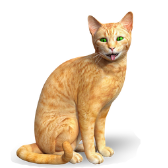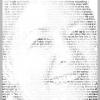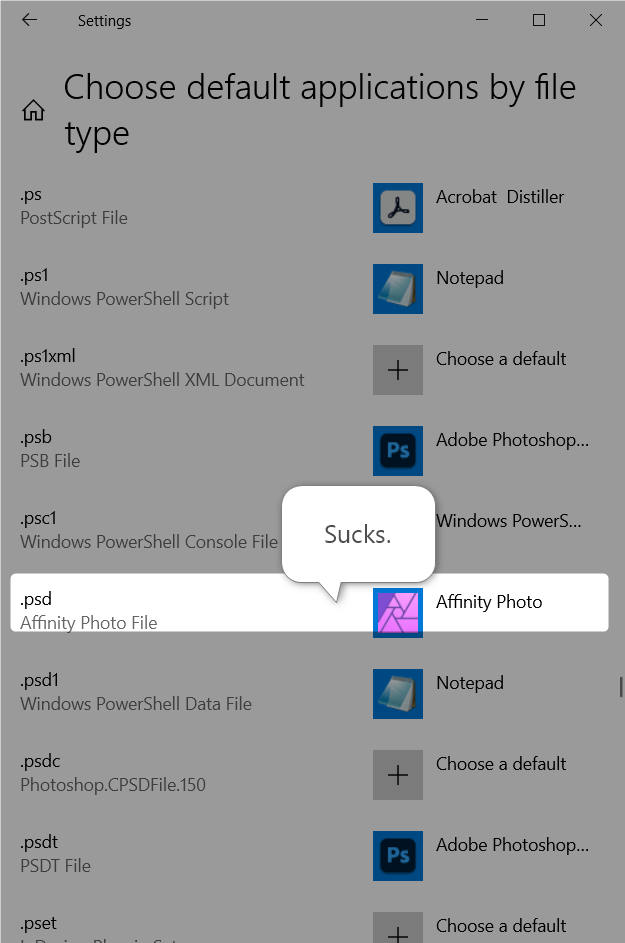-
Posts
407 -
Joined
Profile Information
-
Gender
Not Telling
-
Location
Germany
-
 AdamStanislav reacted to a post in a topic:
Variable fonts support
AdamStanislav reacted to a post in a topic:
Variable fonts support
-
 CoryM reacted to a post in a topic:
Variable fonts support
CoryM reacted to a post in a topic:
Variable fonts support
-

Variable fonts support
hifred replied to Athanasius Pernath's topic in Feedback for the Affinity V2 Suite of Products
Our case for using variable fonts is simple. The fonts we use are licensed from a font foundry and are used in all proper documents: On our website and in printed documents. Exceptions are emails and newsletters, where we must use system fonts. Affinity products do not support variable fonts, which means that we have to stick to InDesign. -
 hifred reacted to a post in a topic:
Variable fonts support
hifred reacted to a post in a topic:
Variable fonts support
-
 hifred reacted to a post in a topic:
No .exe, no interest
hifred reacted to a post in a topic:
No .exe, no interest
-

Menus on Windows
hifred replied to thistle's topic in Feedback for the Affinity V2 Suite of Products
I agree that the Windows Menus (which use less line spacing) look crammed, in comparison with the Mac. -
 João Vítor Martins reacted to a post in a topic:
Control brush flow with shortcut...
João Vítor Martins reacted to a post in a topic:
Control brush flow with shortcut...
-
 3joern reacted to a post in a topic:
Duplicate a layer by alt + drag & drop in layers panel
3joern reacted to a post in a topic:
Duplicate a layer by alt + drag & drop in layers panel
-
 kenmcd reacted to a post in a topic:
Please don't hijack 3rd party filetypes if the 3rd party program is installed
kenmcd reacted to a post in a topic:
Please don't hijack 3rd party filetypes if the 3rd party program is installed
-
 John Rostron reacted to a post in a topic:
Please don't hijack 3rd party filetypes if the 3rd party program is installed
John Rostron reacted to a post in a topic:
Please don't hijack 3rd party filetypes if the 3rd party program is installed
-
I stated why I dislike software messing with user-preferences, without asking for permission. I have no interest in discussing why potential consequences aren't so bad, after all – and can get reverted in "no time".
- 7 replies
-
- psd
- file association
-
(and 1 more)
Tagged with:
-
I am aware of this option. APhoto, besides its own file extensions, had also grabbed quite a few, non-native file formats (such as RAW-formats). Hence, it wouldn't be a matter of mere seconds to revert. Right now, I deal with thousands of graphics files and batch edit them with scripts. I can't afford things to break only because I downloaded another image editor. The Affinity-Makers have it in their hands: They can choose to cause their customers inconvenience and predictable frustration… Or they could respect established customer-preferences. That's why I took the time to post.
- 7 replies
-
- psd
- file association
-
(and 1 more)
Tagged with:
-
Hi Developers, Today installed Affinity Photo 1.10.4 on Windows, but my currently my main Editor is Photoshop CC. Minutes later I discovered, that Affinity Photo has assigned itself as the default Editor for a great variety of file-formats, including Photoshop native PSD. Simply taking over the native file extension should never happen and could get avoided with a simple check. But also with non-proprietary formats and a popular alternative image editor already one should assume that users have some preferences and workflows established. These are worth being respected. A new roommate shouldn't mess everything up on the first day... There's no potentially positive outcome of such rude manners. Not a single user will appreciate that PSDs now open with another Editor and feel invited to edit PSDs with APhoto from now on. Every single user who runs into this will curse – and is forced to waste time to re-establish the previous assignments. I (paying customer) took the shortcut and uninstalled APhoto. That's certainly not at all what you want – but the quickest option.
- 7 replies
-
- psd
- file association
-
(and 1 more)
Tagged with:
-
 Rich reacted to a post in a topic:
[Poll] Do you need a DAM? And what should it be like?
Rich reacted to a post in a topic:
[Poll] Do you need a DAM? And what should it be like?
-
 hifred reacted to a post in a topic:
Affinity Photo Batch Job – alternative way to assign files?
hifred reacted to a post in a topic:
Affinity Photo Batch Job – alternative way to assign files?
-
Hehe, I really only asked whether one can access batch processing in another way where Drag and Drop is supported. I might have missed it. Walt's method would be difficult to use in our case and creating folders would mean moving hundreds of GB, just for exporting. We could easily create folders based on Metadata in our DAM but deliberately decided against doing this – tagging is far more powerful. I think I have my answer: No, there's no drag and drop enabled way to add images to an export queue. 👋 PS: I checked the thread @David in Яuislip linked but the search-method doesn't help us either. Hopefully, Affinity adds Drag and Drop soon, because the overall Exporter performance is very nice.
-
Thank you. Imagine a folder with tremendously many files. They are instantly sortable in a way every DAM software can deal with – but not the native Windows File Picker. I can not identify by file-name or by preview-image what we want to happen with the particular file (output format / size). Hence, my question.
-
Hi All, we have a huge image-folder with thousands of PSD files which we want to batch export to PNG. While Affinity Photo does this quickly we run into limits with the GUI – as seemingly one can only add files to the job with the OS-default browse dialog (win10 in our case). We want to process several hundreds of images at once – and the Windows native file picker which doesn't work with file-metadata totally isn't up to the task. All image in our folder are cleanly grouped with keywords – it would be super simple to drag and drop all similar assets to the processing queue – but unfortunately this method seems not to be supported at this time. Is there possibly another way to access the batch tool, where drag and drop is supported? We for overall workflow reasons prefer not to create subfolders, merely for exporting.
-
 GalaxySurfer reacted to a post in a topic:
Option to turn off the "Tool Toggle" to last brush.
GalaxySurfer reacted to a post in a topic:
Option to turn off the "Tool Toggle" to last brush.
-
 McPhearson reacted to a post in a topic:
Can I create a gif using affinity photo
McPhearson reacted to a post in a topic:
Can I create a gif using affinity photo
-
 Gregory Chalenko reacted to a post in a topic:
nudge, rotation, zoom, clone etc.
Gregory Chalenko reacted to a post in a topic:
nudge, rotation, zoom, clone etc.
-
Thanks for your always very well-made videos! These additions are a good idea – but they (like already the older interactive brush controls) are all hooked up with a 100% mouse input centric mindset. I just tried the feature out with a Cintiq 27 pen display. Only by trying several times in a row, I managed to at all enter the advanced stroke controls. It requires me to hold Alt, touch the glass (LMB) and at the same time hold down a key (RMB) on my pen and to hope, that everything registers. After that I was practically locked inside pen rotation mode. It might somehow be possible to map some keyboard-button or one of the precious brush keys to RMB and LMB pressed at the same time. Then again I know that this can get done better and it's demonstrated in various other graphics applications I use. You guys are completely missing out by not supporting all features of the Wacom driver properly... Having to actually touch the screen with the brush (→ LMB) in order to change its width, falloff or anything else feels just awfully wrong: Imagine you were standing in front of an easel, had a broad colour-loaded brush in your hand and you want to switch over to a small brush. What Affinity apps require you to do is press that fat brush onto the canvas while pressing your ear lobe and hoping for the best. When everything works well and all events register, the fat brush doesn't leave any traces, but transforms to the desired small brush. This really all would not have to happen, if you supported Hover-Click, as – sorry – everyone else. This option lets you change all demonstrated brush properties, while hovering over the display / tablet. Hover-Click is pretty close to a analog mixing palette. Nearby, offers all options, but no danger involved – as some safety-distance is kept. I sure wrote 3 feature requests on how interactive brush manipulation could get enhanced. Realizing that nobody reads this and takes a note – and seeing that developer resources are wasted to create further implementations that are foreseeably useless with the best input devices in the market is not particularly attractive.
-
 hifred reacted to a post in a topic:
PSD smart object support in Photo 1.8.0 (split)
hifred reacted to a post in a topic:
PSD smart object support in Photo 1.8.0 (split)
-
Here is what I disliked about your post. I criticized repeated, demonstrably wrong marketing promises by Serif. You keep talking these false announcements down and ridicule the criticism ('he he, actually not too bad with brand-new hardware – just imagine how the software would fly with Hardware Acceleration'). And you are also bold enough to start criticizing me and my judgement. You effectively try turning things around and to totally side-track the discussion. That's a discourse method I generally don't accept. And yes – your statement, that intimate code insight is required to judge whether Affinity can fully support Smart Objects remains nonsensical. I won't start explaining – but you might read my first post again and ask yourself why I picked these two samples. [Edit: Now I see that you even draw (here utterly irrelevant) Adobe marketing in. You might consider a career as a political advisor – you're good at this.]
-
 hifred reacted to a post in a topic:
PSD smart object support in Photo 1.8.0 (split)
hifred reacted to a post in a topic:
PSD smart object support in Photo 1.8.0 (split)
-
This sure would appear more honest. All image editors who have somewhat decent Photoshop background know right away that this promise is wrong – I at least knew, without even trying. Considering the size of the Photoshop user-base this should be quite a few advanced users (easily 6 or 7 digits) who know, that what they just read is merely hollow marketing blurb. I have even checked "vastly improved 1.7 performance on Windows" (wrong) and also tried 1.8 support for all Smart Objects"(wrong too). While I sympathized with Affinity from day one, I can not deny that such experiences do impact my inclination to try things out a third time (although I'm a licensed customer). What Affinity marketing does seems totally detached from what sane developers, who without any doubt do work at Serif would state. It's rather marketing folks (who obviously have no idea what they are saying) that drive advanced users away. Yes. I did not do a lot of tests, but Smart Objects which were created as an encapsulated sub-set of a file seem to work. Any Smart Objects that encapsulate non Photoshop-native data seem to get disregarded. I could not try if Smart Objects that contain externally referenced files do work, as my CS6 doesn't support this yet. Someone with CC had to test this.








